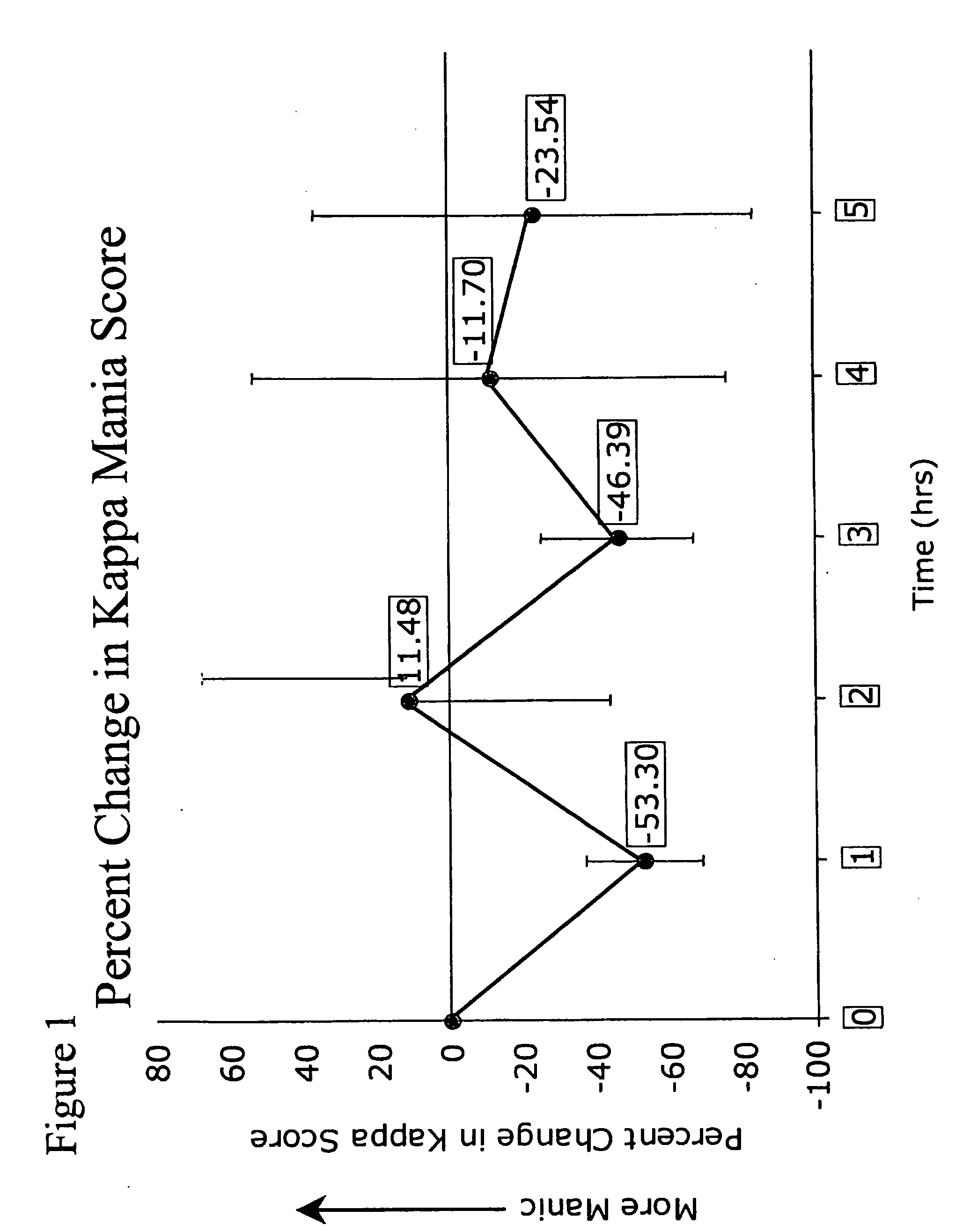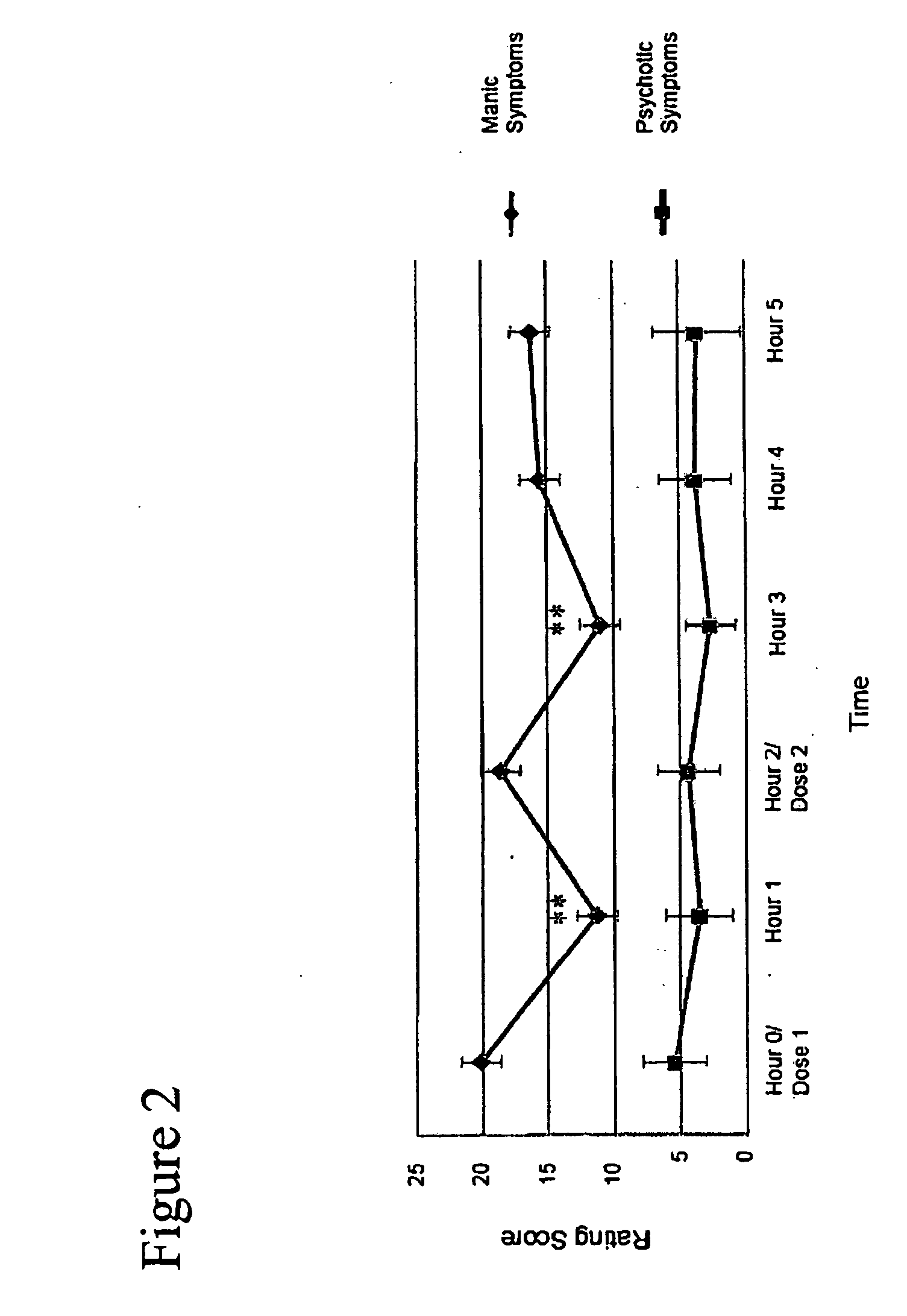Methods for the treatment of mood disorders
a mood disorder and treatment method technology, applied in the field of mood disorders, can solve the problems of falling out of favor with the use of potentially addictive opiate treatment for mood disorders, and achieve the effect of stabilizing the mood of a human
- Summary
- Abstract
- Description
- Claims
- Application Information
AI Technical Summary
Benefits of technology
Problems solved by technology
Method used
Image
Examples
example 1
Radioligand Binding Assays
[0042]Compounds can be characterized in radioligand receptor binding assays, using ligands that are specific for the mu, delta and kappa receptors. The binding assays may utilize guinea pig brain membranes or stably transfected Chinese Hamster Ovary (CHO) cells expressing each of the three opioid receptors. Membranes can be isolated from CHO cells that stably express either the human mu, delta or kappa opioid receptors. At approximately 80% confluence, the cells are harvested by the use of a cell scraper. The cells and media from the plates are centrifuged at 200×g for 10 mm at 4° C.; resuspended in 50 mM Tris-HCl, pH 7.5; homogenized by the use of a Polytron; centrifuged at 48,000×g for 20 mm at 4° C.; and resuspended in 50 mM Tris-HCl, pH 7.5, at a protein concentration of 5-10 mg / ml, as determined by the Bradford method. The membranes are stored frozen, at −80° C. until use.
[0043]Cell membranes are incubated at 25° C. with the radiolabeled ligands in a f...
example 2
[35S]GTPγS Binding Assays
[0044]Membranes from the CHO cell lines, expressing either the mu, delta or kappa receptor, are incubated with 12 concentrations of each compound for 60 minutes at 30° C. in a final volume of 0.5 ml of assay buffer (50 mM Tris-HCl, 3 mM MgCl2, 0.2 mM EGTA, 100 mM NaCl, pH 7.5) containing 3 μM GDP and 0.08 nM [35S]GTPγS. Basal binding can be determined in the presence of GDP and the absence of test compounds, and nonspecific binding can be determined by including 10 μM unlabeled [35S]GTPγS. The incubation can be terminated by filtration under vacuum through glass fiber filters, followed by three washes with 3 ml ice-cold 50 mM Tris-HCl, pH 7.5. Samples can be allowed to equilibrate overnight and can be counted in 2 ml Ecoscint A scintillation fluid for 2 minutes in a liquid scintillation counter.
[0045]For [35S]GTPγS binding assays, percent stimulation of [35S]GTPγS binding is defined as [(stimulated binding-basal binding) basal binding]×100. Percent stimulati...
example 3
Intracranial Self-Stimulation (ICSS)
[0046]Intracranial self-stimulation (ICSS) is highly sensitive to the function of brain reward systems. In this assay, rodents respond to self-administer rewarding electrical stimulation through electrodes implanted within the limbic system. Changes in the rewarding efficacy of the stimulation shift the rate-frequency functions: leftward shifts (reflecting decreases in ICSS thresholds) imply that the stimulation is more rewarding as a result of a treatment, whereas rightward shifts (reflecting increases in thresholds) imply that it is less rewarding. The effects of many types of treatments on ICSS have been described. Most drugs of abuse decrease the amount of stimulation required to sustain responding: this is indicated by leftward shifts in rate-frequency functions and decreased ICSS thresholds. Conversely, agents that block drug reward (dopamine or kappa-opioid receptor agonists) increase the amount of stimulation required to sustain responding...
PUM
| Property | Measurement | Unit |
|---|---|---|
| concentration | aaaaa | aaaaa |
| volume | aaaaa | aaaaa |
| pH | aaaaa | aaaaa |
Abstract
Description
Claims
Application Information
 Login to View More
Login to View More - R&D
- Intellectual Property
- Life Sciences
- Materials
- Tech Scout
- Unparalleled Data Quality
- Higher Quality Content
- 60% Fewer Hallucinations
Browse by: Latest US Patents, China's latest patents, Technical Efficacy Thesaurus, Application Domain, Technology Topic, Popular Technical Reports.
© 2025 PatSnap. All rights reserved.Legal|Privacy policy|Modern Slavery Act Transparency Statement|Sitemap|About US| Contact US: help@patsnap.com



